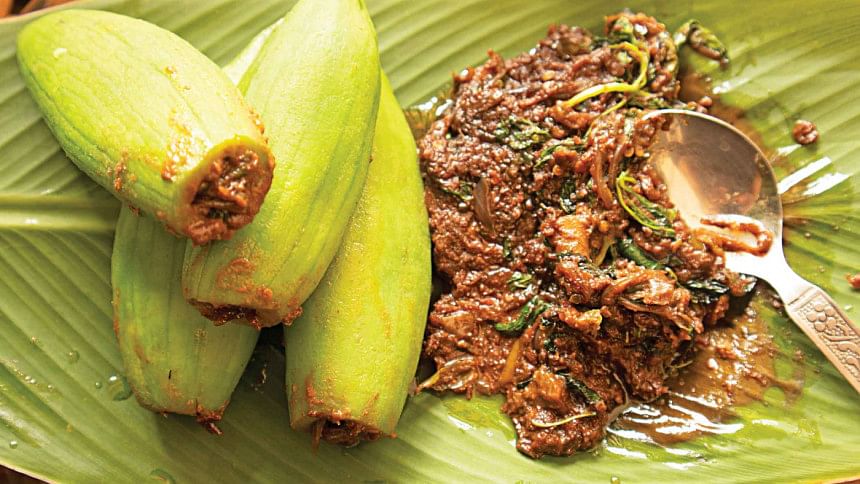Flavours from the hills


Cuisine is an important part of Chakma lifestyle. Like their distinctive culture, the unique style of cooking, and techniques using natural ingredients makes their cuisine distinguishably flavourful. From meat to poultry, wild vegetables, roots, and stems are prepared and consumed in different ways.
Sidol and suguni are probably the two ingredients most people think of when it comes to Chakma food. Sidol is a paste made from fermented shrimp and various fishes, whereas suguni is sun-dried fish or sun-dried shrimp, known as "eje guri' in Chakma dialect.
Chakma cuisine is also known for the lack of spices, and profuse use of fresh herbs, which are the leaves, flowers, or stems of various seasonal hillside plants for flavouring, as well as serving as a garnish.
There are also many lesser known edible plants of Chittagong Hill Tracts used as ingredients, eaten raw or cooked as vegetables. Many of these are seasonal plants that grow during monsoon and remain available for the next four to six months only.
Ingredients like bamboo shoots, edible ginger flower, turmeric flower, wild mushrooms, Thai dragon tongue, kanai dinga in Bangla etc. are only available from mid-April to mid-September. Due to this reason, to ensure local supplies year-round, Chakma cooks preserve many ingredients from early winter by sun-drying or using other traditional drying techniques. Sliced vegetables are hung or spread out on cane trays and kept on a cane shelf made at a height above traditional mud stoves.
In most recipes, the basic ingredients are sidol, suguni, garlic, onions, bird-eye-chilli, sabarang, lemon basil, coriander leaves, fuji or wild parsley, cilantro, turmeric powder, salt and sometimes few drops of oil.
When it comes to fish or meat recipes, traditionally there is no use of spice, garam masala or curry powder; only herbs such as lemon basil, wild parsley, coriander leaves, and cilantro, along with onions, garlic, good amount of wild ginger, bird-eye-chilli, turmeric powder, salt and little amount of oil are used. Some prefer to use only small amounts of cumin powder in meat dishes.
Almost all leafy vegetables and herbs are eaten raw. Some are pre-boiled for a few minutes and eaten with a side dip, chilli-coal roasted sidol sauce, sidol-morich-battye or garlic-chilli salsa like ron-morich battye, or consumed as green salads by mixing these sauces. There is also a popular charcoal roasted or burnt dry-fish salsa, suguni-morich battye or suguni hurbo (dry-fish-salad) served as a side dish to be consumed with leafy vegetables. This is a must-have for those who love to eat dry fish.
Besides using unique ingredients for preparation of food, Chakma cooking utilises varied local customs and techniques in preparing the dishes.

Sumoh gorang
Sumoh in Chakma dialect refers to a tube. Any dish cooked using a bamboo sumoh is called a sumoh-gorang. Thus, bamboo-chicken is known as sumoh-huro.
The traditional sumoh cooking process is used to cook most meat, fish, dry fish dishes, and glutinous rice.
The meat or fish are mixed with all other ingredients. This serves as the marinade which makes the meat tender. This is a crucial aspect of the sumoh method of cooking.
After an hour of marination, the mixture is used to stuff bamboo stems, and the mouth is sealed securely using banana leaf. While the bamboo tube gets cooked on open firewood or coal embers for about 1-2 hours, they are turned periodically so that food is cooked evenly from all sides.
Hebaang
This is a typical Chakma cooking technique of burnt baking. Marinated meat, fish, dry fish, egg or vegetable are wrapped in banana leaf and baked inside a mud/clay stove or on open coal embers.
Traditionally, as only banana leaf layers are used, it is necessary to prepare the leaves by heating both side to make them soft and flexible. Placing all leaves one over another make a thick layer, and protects the dish from direct heat.
The marinated mixture is placed in the middle of the layered leaves, which are then folded to turn into a little pouch. The leaves are carefully tied with the fibre extracted from banana leaves.
The leaves are not themselves eaten, but used only to get the sweet subtle leafy aroma.
Maalah
Maalah dishes are any stuffed dishes prepared traditionally with sautéed sidol, mixed with other ingredients and stuffing such as peeled young bamboo shoots. This is known as bachchuri-maalah. Teasel gourd, wild snake gourd, bitter melon, and wild eggplant maalah can also be prepared in this way.
The vegetables are first boiled and blanched. Then for preparing the filling, they are sautéed to get a shallow-fried, brown skin.
Taaba
A healthy way of cooking and consuming boiled green vegetables with a clear broth. Firstly, dry fish pieces or dry shrimp with required amount of water and salt are simmered for 5-10 minutes. Vegetables are then added to the boiling water over high flame for few minutes until vegetables get cooked. The mixture is transferred into a bowl, leaving uncovered to release all steam. It requires special skills to cook greens without losing their existing colour.

Photo and Food by Chiangmi Talukder Lena

 For all latest news, follow The Daily Star's Google News channel.
For all latest news, follow The Daily Star's Google News channel. 



Comments